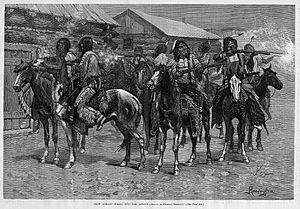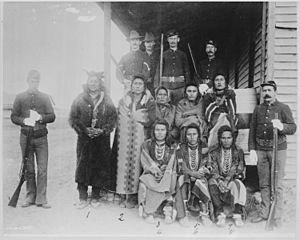Crow War facts for kids
Quick facts for kids Crow War |
|||||||
|---|---|---|---|---|---|---|---|
| Part of the American Indian Wars | |||||||
 "Crow Indians Firing Into The Agency" by Frederic Remington. |
|||||||
|
|||||||
| Belligerents | |||||||
| Crow | |||||||
| Commanders and leaders | |||||||
| Sword Bearer † | |||||||
| Casualties and losses | |||||||
| 1 killed 2 wounded |
7 killed 9 wounded 9 captured |
||||||
The Crow War, also called the Crow Rebellion or Crow Uprising, was the only armed conflict between the United States and the Crow tribe in Montana. It was also the last Indian War fought in that state.
In September 1887, a young medicine man named Wraps-Up-His-Tail, also known as Sword Bearer, led a small group of warriors. They raided a group of Blackfoot people who had taken horses from the Crow reservation. After the raid, Sword Bearer returned to the Crow Agency to share his victory. However, an event happened that led him and his followers to flee into the mountains. In response, the United States Army started a campaign to bring the Crow people back to the reservation. The army was successful.
Contents
Why the Crow War Started
The Crow Incident of 1887
In 1887, the Blackfoot and Crow tribes were having small conflicts. Both sides would raid each other's camps to steal horses. In the late spring, a group of Blackfoot warriors raided the Crow reservation. They took several horses.
Against the wishes of the chiefs, Sword Bearer decided to lead a counter-raid in September. His group was mostly made up of teenagers. These young men wanted to prove their bravery to the older warriors.
Legend says that Sword Bearer got his name after having a vision. This vision told him that if he carried a sword in battle, he would be safe from harm. During the raid, the Crow warriors killed some Blackfoot fighters. They got their horses back without any losses.
When they returned to the reservation on September 30, Sword Bearer made a mistake. He showed off his victory to the Indian agent, Henry E. Williamson. Williamson was not well-liked by the native people. In what became known as the Crow Incident, Sword Bearer and his men rode around Williamson's home. They fired their guns into the air to celebrate. This upset the agent. He came outside to make arrests.
Sword Bearer then fired a few shots into the ground near the agent. Williamson quickly ran back inside. He sent a telegram to the army at Fort Custer. He told them his house was under attack. Local newspapers at the time reported that Williamson's house was shot at. However, it is not certain if this was true. The "Billings Gazette," on October 3, said that the "houses and office of the agent were riddled by bullets" but no one was hurt.
A few days later, Sword Bearer learned that the U.S. Army was looking for him. He and about twenty men left the reservation. They went towards Fort Custer, which was thirteen miles away. They wanted to show the soldiers the "magical sword."
When the soldiers saw the warriors approaching, they thought they were under attack. They prepared a battery of cannon. It had been raining, so when the soldiers tried to fire, the cannons did not work. This made Sword Bearer and his men believe that his special sword truly protected them. The Crow then fled into the Big Horn Mountains, heading for the Little Bighorn River. It was believed that Sword Bearer planned to gather more men there. He especially hoped to recruit from the nearby Cheyenne reservation.
By this time, the lower Crow chiefs were very worried. They told the high chief, Plenty Coups. He ordered the Crow police to start looking for Sword Bearer and his followers. This was to prevent American settlers from panicking. But it was too late. Hundreds of settlers had already started leaving the areas around the Crow reservation by train.
The Battle of Crow Agency
Meanwhile, the United States Army was also taking action. Brigadier General Thomas H. Ruger was put in charge of the soldiers at Fort Custer and Fort McKinney, Wyoming. He was told to lead an expedition into the Big Horn Mountains. His goal was to occupy the Cheyenne reservation. This would stop any native people there from joining the Crow.
The expedition from Fort Custer was led by General Ruger and Colonel Nathan Dudley. It included five troops of the 1st Cavalry. It also had one company from the 3rd Infantry. There was also one troop from the 7th Cavalry. The expedition headed for the mountains on November 4. They brought two Hotchkiss guns with them.
On November 5, they found Sword Bearer and his followers. They were camped near the river, about three miles north of where General George A. Custer was defeated. This famous battle was the Battle of Little Bighorn in 1876. Some of Sword Bearer's followers had fought in Custer's battle. Some of the Crow police were also veterans.
According to an American soldier, Private George Morris, there were about 3,000 native people in the camp. They were facing only a few hundred soldiers. At 10:30 am, General Ruger gave the Crow an hour and a half to surrender. They could do this by moving to a special area to give up their weapons. Morris described it: "Indians who wanted to be our friends were to move their camp to the neighborhood of a certain tall birch. The rest would be considered hostile, and destroyed. ... It was a tense morning as we watched the slow drift of the Indians toward that birch tree. Those who went there were disarmed, and a guard posted."
When the time limit ended, 600 native people were still in the camp. General Ruger ordered his men to get ready. The battalion of 1st Cavalry was placed on the left side of the camp with Colonel Dudley. The troop of 7th Cavalry was on the right side.
At the same time, Sword Bearer appeared. He led 120 to 150 warriors in a charge on horseback against the soldiers. The attack was pushed back. The Crow retreated to the wooded area along the river. They had already dug rifle pits there. The American cavalry then attacked back. Morris said: "The cavalry charged and took a volley from the Indian camp. At 200 yards we leaped from our horses and flattened out behind clumps of sagebrush. We traded shots for a while, until two Hotchkiss field guns on the hill began dumping two-inch into the Indian camp. That broke them."
During the fighting, Sword Bearer tried to encourage his men. He rode out in front of the soldiers. But he was hit by rifle fire and fell to the ground, wounded. Eventually, some of the Crow began to surrender. But Sword Bearer and others stayed in the mountains. They only surrendered later to the Crow police.
During the march out of the Big Horn Mountains, one of the policemen shot Sword Bearer in the head. He died instantly, and the war ended. One soldier was killed and two others were wounded during this battle, now called the Battle of Crow Agency. Seven Crow warriors were killed, and nine were wounded. Nine more men were taken prisoner. All those who had not fought in the battle were taken to Fort Snelling, Minnesota. The army expedition returned to Fort Custer on November 13.
Who Fought in the Crow War
Native American Forces
The Native American forces were led by Chiefs Old Bear, Two Moon, and Little Coyote (Little Wolf). There were about 60 to 250 warriors in total.
| Tribe | Leader | Size |
|---|---|---|
| Crow | Sword Bearer | 120 –150 Warriors |
United States Army Forces
On November 5, 1887, Brigadier General Thomas H. Ruger was in command of the United States Army forces.
| Expedition | Regiment | Companies and Others |
|---|---|---|
|
Command |
1st Cavalry
|
|
| 7th Cavalry |
|
|
| 9th Cavalry
|
|
|
| 3rd Infantry
|
|
|
| 7th Infantry
|
|
See also
 In Spanish: Guerra de los crow para niños
In Spanish: Guerra de los crow para niños


